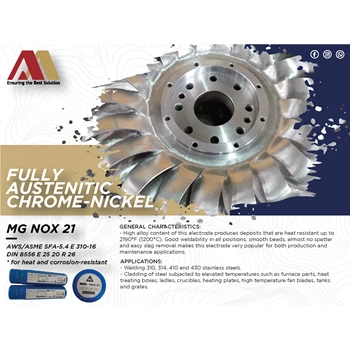
STAINLESS STEEL & HEAT RESISTANCE MG NOX 21
Kategori
Update Terakhir
18 / 04 / 2024
Minimum Pembelian
1 Box
Dilihat Sebanyak
295 Kali
Harga
CALL
Bagikan
+ Keranjang
Spesifikasi STAINLESS STEEL & HEAT RESISTANCE MG NOX 21
Cari berbagai macam dari pilihan terlengkap Kawat Las. Cari penawaran terbaik dan termurah dari supplier terlengkap di Indonetwork.
Cari berbagai macam dari pilihan terlengkap Kawat Las. Cari penawaran terbaik dan termurah dari supplier terlengkap di Indonetwork. Kami Menjual Kawat Las MG NOX 21 Kualitas Terbaik, Terlengkap dan Harga Kawat Las Terbaru.
GENERAL CHARACTERISTICS:
High alloy content of this electrode produces deposits that are heat resistant up to 2190°F(1200°C). Good weldability in all positions, smooth beads, almost no spatter and easy slag removal makes this electrode very popular for both production and maintenance applications.
APPLICATIONS:
Welding 310, 314, 410 and 430 stainless steels. Cladding of steel subjected to elevated temperatures such as furnace parts, heat treating boxes, ladles, crucibles, heating plates, high temperature fan blades, tanks and grates.
CALL FOR DATA SHEET REQUEST
OUR OFFICE: Kawasan Menara Permai. Jl. Raya Narogong km-23,8 Cileungsi Kabupaten Bogor Jawa Barat
Back to home ➡ PT. Alpha Austenite
GENERAL CHARACTERISTICS:
High alloy content of this electrode produces deposits that are heat resistant up to 2190°F(1200°C). Good weldability in all positions, smooth beads, almost no spatter and easy slag removal makes this electrode very popular for both production and maintenance applications.
APPLICATIONS:
Welding 310, 314, 410 and 430 stainless steels. Cladding of steel subjected to elevated temperatures such as furnace parts, heat treating boxes, ladles, crucibles, heating plates, high temperature fan blades, tanks and grates.
CALL FOR DATA SHEET REQUEST
OUR OFFICE: Kawasan Menara Permai. Jl. Raya Narogong km-23,8 Cileungsi Kabupaten Bogor Jawa Barat
Back to home ➡ PT. Alpha Austenite
PT. Alpha Austenite
COMPANY OVERVIEW
PT ALPHA AUSTENITE was founded in 1979, as subsidiary of PT TIRA AUSTENITE Tbk, formerly located at Pulogadung Industrial Complex, East of Jakarta, the first industrial complex in Indonesia . Due to our business expansion; starting a new production division in 1999, so the whole activities was moved to a larger area located at Industrial complex MENARA PERMAI, Cileungsi, BOGOR, approximately 40 km south of the Jakarta city.
In 1981, we started production for bronze casting in the shape of continuous cast solid and hollow bars, centrifugally cast and also sand cast representing several grades, like LG2, LB2, AB2 and some new developed grades. In 1982, we started the production maintenance electrodes especially for repair and maintenance usage, for example: crack repair, rebuild worn tools by hardfacing,for cast iron, copper, bronze and tool steel.
FACILITIES
Production
Here, in Alpha Austenite, we have 2 kinds of melting furnaces, the large and the medium one, which can handle 1,7 tons per shift, with 1,2 tons will be handled by the gas furnace and 500kgs by induction furnace. Moreover, several machining equipment are running every day to fulfil our customer needs. Our Maintenance Electrode production can cover up to 1,4 tons high quality electrodes per shift.
Methods
Continuous casting is carried out using special casting equipment, in which molten bronze is poured from the holding chamber through cooled graphite dies attached to the holding chamber, then pulled through a roller. Continuous castings in the form of various solid or perforated forms.
Graphite dies are prepared according to standard dimensions and shapes or according to customer requirements. Dies are heated for a while to make sure they are dry. The withdrawal process is carried out by taking into account the holding time, tensile speed, cooling and the visual appearance of the castings. In this process, we can make a variety of shapes with a maximum size or with an outer diameter of up to 8 inches.
Centrifugal casting is the process of pouring molten metal into a rotating mold cavity so that the centrifugal force occurs. The liquid presses against the mold walls until the liquid solidifies. The cooling system is done by spraying water on the mold walls. Centrifugal casting molding equipment is a tube that is placed-horizontally on a roller. When this process is done, it will produce cylindrical hollow castings with various sizes depending on the size/diameter of the molds. The centrifugal casting process produces high quality bronze castings with better mechanical and visual properties than the sandcasting process.
Sand casting process requires a silica sand to be formed in such a way as to match the shape of the desired plane. Then the result of the sand formation will become a mold so that the finished shape of the bronze is in accordance with the existing sand mold. The basic principle is that molten bronze is poured from the furnace ladle into the molded sand. Sand is usually made by molding silica sand added by water glass or chemical resin. In the special case of making precision castings, resin sand molds are made with coated sand. The quality of the sandcasting product depends on the
process control. The control process is carried out by personally qualified, starting from raw materials to every stage in the production process.
Cek lokasi kami di Google Maps Alpha Austenite.

Premium Ruby
17 Tahun
Kawasan Industri Menara Permai | Jl. Raya Narogong KM-23,8, 16820 - Kabupaten Bogor, Jawa Barat, Indonesia -16820
Login Terakhir 18 / 03 / 2024


